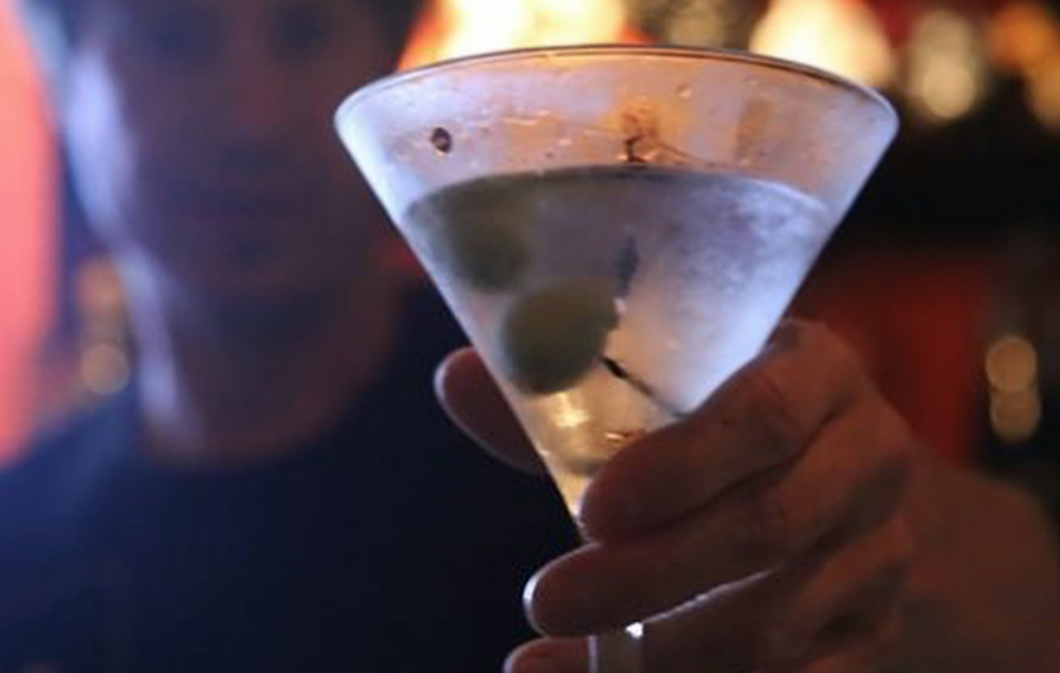Ever since its inception, the martini cocktail has been the drink of choice for all manner of sophisticates from international shecret agentsh to anthropomorphic cartoon dogs. But how do you order one?
If you walk up to the bar and ask for a martini, your bartender is going to want to know how to you want it. And what do you say? You felt so cool and suave walking up and ordering it in your little sports coat, but now that you're there being asked about it, you're coming up blank. Or maybe you've heard some of the lingo on TV: uhhh, I'll take it dirty! you say, in spite of having no idea what that means. But then you see her start to pour olive brine into her shaker and you're having regrets. How about we just skip all the embarrassment of acting like you know what you're doing and let's talk about how to order a martini.
Let's start with what makes a martini. The martini, in it's most classic iteration, is a cocktail made mostly of gin with a bit of vermouth, the ratio usually being 1 part vermouth to every 5 parts of gin, and garnished with a lemon peel or an olive. Now, not everybody's into gin and everyone wants to be a little more like James Bond. If either of those are true for you, ask for a vodka martini and they'll switch out the base gin for vodka. That said, if you haven't tried a lot of gins, gin tends to vary more in its flavor between brands than vodka due to the nature of its creation (different gins tend to be distilled with botanicals unique to the brand), so it's worth a little bit of experimenting before you throw the baby out with the bathwater (or the Beefeater's with the Seagram's, as the case may be) .
Next, let's talk about what makes a martini dry or wet. First of all, let's get something straight about vermouth—there is dry vermouth and there is sweet vermouth. Dry is a term used often in describing the taste of an alcohol. It doesn't necessarily imply that there's a bitter taste so much as it implies that there's a lack of sweetness. That distinction is going to be important in a minute here, as things might get a little confusing. Just stay with me.
Dry and wet in martini terms refers specifically to how much dry vermouth is added to the martini. This next part isn't exactly intuitive, so you might want to read it twice: the dryer a martini is, the less dry vermouth it has. The wetter it is, the more dry vermouth it has. What the hell, right? Well, the thinking is that the dry vermouth is still less dry than the vodka or gin it's being added to. Apparently Winston Churchill used to take his martinis "bone dry"—which is to say that he was a man who liked his gin. In review: a dry martini has a higher ratio of gin/vodka to dry vermouth (5:1, 10:1, 15:1, etc.) and a wet martini has a lower, more equal ratio of gin/vodka to dry vermouth (3:1, 2:1, and even 1:1 if you like it so wet you could take a swim in it)
But what about sweet vermouth? All we've heard about is the dry stuff. Well, that comes in when talking about a "perfect" martini. "Perfect" in mixology just means that when the recipe calls for vermouth, equal parts dry and sweet vermouth are used. It goes without saying, but if you're used to drinking spritzers, coolers, alcopops, and sweet wines, this might be the best way to start off if you're absolutely headstrong about ordering a martini.
These are the main parts of ordering a standard martini, but there are also some variations that are worth mentioning: the dirty martini, the Gibson martini, and the Vesper. A dirty martini takes the olive garnish idea a step further by introducing olive brine as an ingredient in the mix. We call it dirty because of the cloudy, green look that the brine adds to the mixture and the salty taste it gives. This is my favorite way of ordering a martini and it's considered a nice easy way to get into them if you have a sodium-friendly palate. A Gibson is a standard martini with the lemon or olive replaced with a pearl onion (I've heard it goes well with a vodka martini if that's your thing). Then there's the Vesper. This was invented by Ian Flemming himself when he penned the first James Bond book, Casino Royale. Though the movie Bond likes to keep things simple with his vodka martini, the novel Bond likes to keep the bartender on his toes:
- "A dry martini," [Bond] said. "One. In a deep champagne goblet."
- "Oui, monsieur."
- "Just a moment. Three measures of Gordon's [gin], one of vodka, half a measure of Kina Litllet [(a wine-based aperitif)]. Shake it very well until it's ice-cold, then add a large thin slice of lemon peel. Got it?"
- "Certainly, monsieur." The barman seemed pleased with the idea.
- —Ian Fleming, Casino Royale, Chapter 7, "Rouge et Noir'
- Now, due to that Kina Lillet (which is rare as all get out) this may be a pain-in-the-ass drink to make unless you're in a high-class bar or at least one with a lot of variety, so if your bartender can make you one with no further questions, tip the man or lady well. They really know their stuff. Alternatively, you could ask for one of these as a substitute for the Lillet. Actually, overall, you'd be best off just not ordering this in the first place. Most bartenders won't be as pleased with the idea as this particular Frenchman.
Okay, stick with me. We're through the worst of it. We've got all our ingredients and now we're into the part where we're asked the big line: shaken or stirred? This is exactly what it sounds like: do you want a martini that's thrown in a mixer, shaken with some ice, and then strained into a glass, or would you like it stirred in a glass and then strained? Now, this part isn't as important to the casual drinker as James Bond would make it seem. In most cases, you probably won't be able to tell the difference. However, some would insist that some martinis are meant to be stirred and others are meant to be shaken. I won't get into all that, but I will say that you're more likely to get little bits of crushed ice in your drink if you order it shaken. Go with your gut on this one; experiment a little. Don't worry about what James Bond wants.
Lastly, you've got to decide whether you want to keep your ice and what you want for a garnish. No ice? Tell them to keep it straight or straight up. You want ice? Tell them you'll have it on the rocks. Want a twist or an olive? Just say so.
That's about all there is in ordering a martini. So let's review by making a couple orders here:
"Give me a Beefeater martini, straight, medium dry."
Your bartender would then give you a martini made with Beefeater gin, a touch of dry vermouth, but not too much, with no ice. They may garnish it with either a twist or an olive.
"Give me a dirty vodka martini straight up, wet."
Your bartender would give you a martini with olive brine, vodka, no ice, and with plenty of dry vermouth"
"Give me a perfect martini on the rocks"
Your bartender would make you a gin martini with equal parts dry and sweet vermouth and then pour it into a tumbler glass with ice in it.
"Give me a martin dry as a moon rock with a twist"
Your bartender would give you a glass of gin with a lemon twist in it—possibly with a drop or two of dry vermouth.
Those are just a few examples of the many ways you can order a martini. The beauty of the drink is that you can be specific or non-specific as you like it. Some bartenders may insist that you give a little bit of detail so that they can make it how you like it, but there's also nothing wrong with telling them to make it their favorite way if you want to explore a little or you just can't be bothered to remember any of this stuff. Ultimately, a good bartender will know his mixed drinks, and if you tell him the kind of drinks you tend to like, he should be able to help you put one together that would best suit your tastes. If all else feels, there's nothing wrong with a whiskey soda or a vodka cranberry. At least with those two, all the ingredients are right in the name!



















